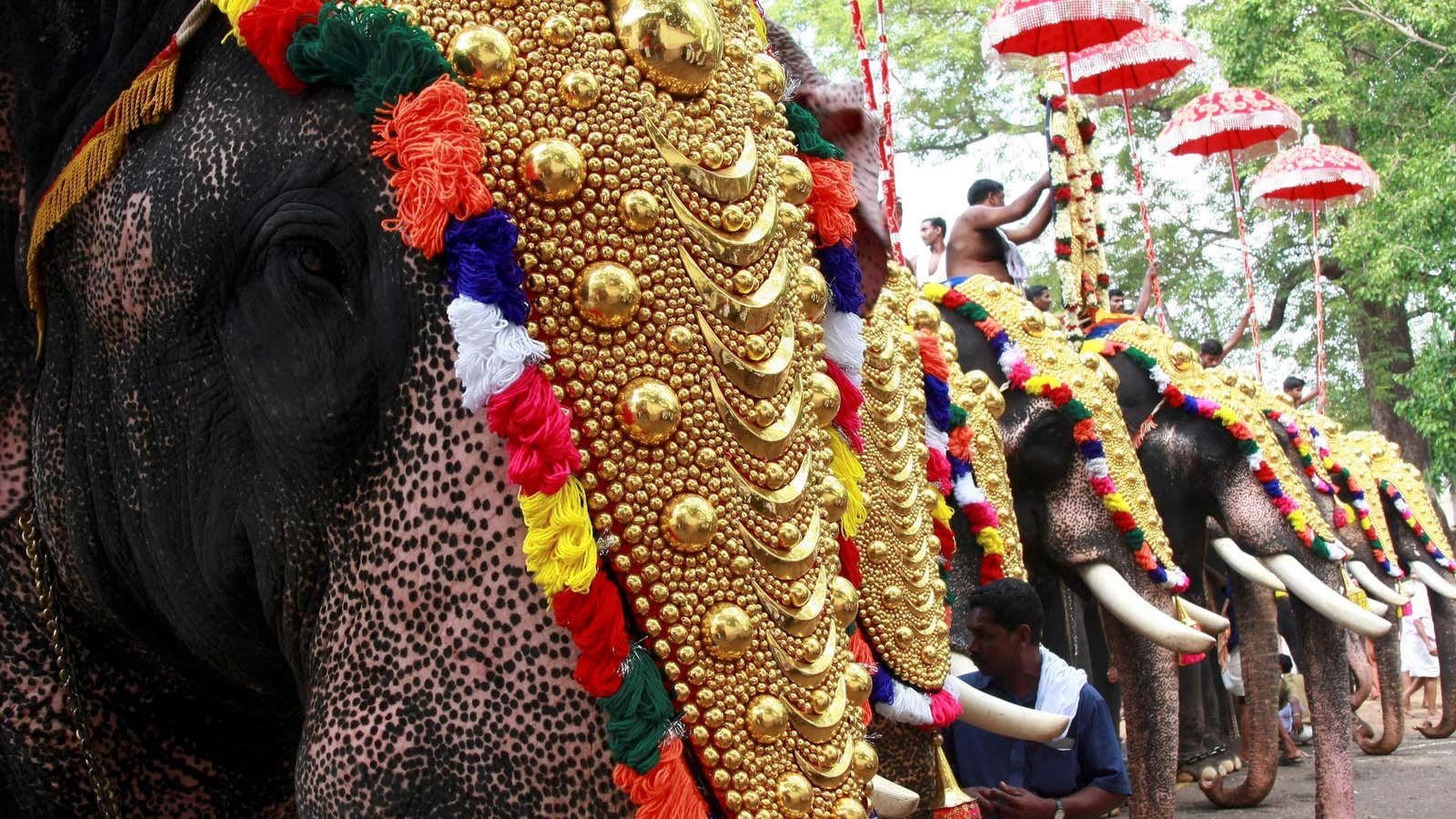Kerala is finally coming to the rescue of its abused and tormented captive elephants.
The southern coastal state, home to around a fifth of these 2,454 domesticated pachyderms in India, will take their custody if they are tortured or tormented by owners and mahouts, the New Indian Express newspaper reported on June 11. Owners unable to look after their old elephants can also hand them over for a nominal fee, Kerala forests and wildlife minister, K Raju, told the state legislative assembly.
The move follows a series of elephant deaths reported in the state—34 in 2018 alone—mostly due to lack of rest and poor upkeep. This is despite the state training 159 mahouts. “Sometimes, elephants in musth are paraded in festivals. Owners shuttle the jumbos between festival venues, violating norms. There were incidents where injured elephants were paraded in festivals and were denied food,” Raju said.
Now, the government will move such “Sahyaputras”—“sons of the Western Ghats,” as elephants are often known in Kerala—to a rehabilitation centre in the state capital Thiruvananthapuram. The facility is being given Rs108 crore ($15.6 million) facelift for this.
The bond
Kerala has the second-highest number of captive elephants in India. However, only 32 of the over 500 have valid owners, according to an elephant census conducted by the state forest department. The rest are kept by private individuals and various temple managements illegally, The New Indian Express reported on March 3.
Indeed, elephants have been an inseparable part of Kerala’s ancient temple tradition.
No major temple festival or procession—Kerala has over 10,000 of them annually— is complete without a tusker. Many of these animals, regulars at specific temples, are legends and celebrities among the adoring public.
One such is Techikkottukavu Ramachandran, a 10 feet 5 inches giant, said to be India’s tallest elephant. He is the star attraction at the biggest of all Kerala temple festivals, the Thrissur Pooram, held every April and best known for its great march of 30 lavishly caparisoned elephants and the invigorating public musical concert.
This year, though, the 55-year-old tusker was also the centre of a major political controversy. The animal, blind in one eye, was banned from being paraded at the festival after a veterinary team declared it unfit. However, the Kerala high court left the final decision to the local administrative head, who in turn, gave a conditional nod.
The primary reason behind the row around “Raman,” as this elephant is lovingly called in Kerala, is simply that he is dangerous. He has killed at least 13 people—two in February this year—and three other elephants till now, according to The News Minute.
This adulation of Raman in Kerala is symbolic of the state’s relationship with elephants. Yet, it hides a darker side.
The torment
Between 2015 and 2017, over 70 captive elephants died under “unnatural conditions and at a young age” in private custody in just three states Kerala, Tamil Nadu, and Rajasthan. “Most of these deaths are due to torture, abuse, overwork or faulty management practices,” Suparna Ganguly, president of the Wildlife Rescue and Rehabilitation Centre told BBC in April 2018.
Between November 2019 and March this year, seven captive elephants reportedly died in Kerala, often prematurely in their prime (20-40 years of age).
It is no secret that most of these animals are overworked and ill-fed. During festivals, they have to stand for long hours bearing loud noise of drums and firecrackers. Shuttling from festival to festival, elephants have to often travel long distances in cramped trucks under a scorching sun. Walking on tarred roads is another routine hazard. Most of these elephants, who are old and weak, are also sometimes beaten mercilessly by drunk mahouts.
As in the case of Raman, there have been innumerable cases of these animals going berserk and killing humans—mahouts, owners, members of the general public—and other elephants.
Elephants are afforded maximum protection under section 40 (2) of India’s Wildlife Protection Act, 1972. They were also declared India’s heritage animal in 2010. The Act also bans the sale of captive elephants not registered with the forest department. Yet, people continue to exploit loopholes to commercially exploit these animals at will.
Lastly, despite having a large population of elephants, India is ill-prepared to protect them. The country does not have enough places to shelter rescued and ailing elephants.
The Kerala government’s latest move could be a tentative first step.
